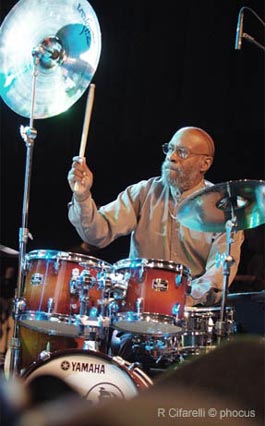ERIC KAMAU GRAVATT, drums |
|
|
 |
|
Pronunciation:
ERIC - er' ik (sounds like "air rick") [Scandanavian; Old Norse "Eirikr" <Germanic*"aizo", honor (akin to Germanic "ehre", honor) +base akin to Latin "Rex"(see Rich) hence literally "Honorable Ruler"]
KAMAU - KA(boom) MAU(rhymes w/POW) [Gikuyu, "Quiet Warrior"]
GRAVATT - GRA (mmarian) VATT (rhymes w/yacht) [Welsh? "a griffin"?]
Acknowledgements
Much acknowledgement and respect I have for my principal teachers; "Sharpnack Street Ray", Mr. George Elias Lockhardt II, the late Dr. J. R. Mitchell, Mr. Silas Kinsey, the late Ms. Edith Willard, the late Mr. Adnan Barakat, Lloyd Courtney and the late Mr. Warren McLendon.
Playing Experience: Since my Philadelphia Pennsylvania youth, I have often had the pleasure of playing drums on stage in either an ensemble or orchestral setting before literally thousands of people, performing music with Freiderich Gulda, Freddie Hubbard, The District of Columbia Youth Symphony, Albert Ayler, Don Ayler, Horiuchi Makoto, Roberta Flack, Sonny Fortune, The Minnesota Music Theater Company, The Oakland Youth Symphony, Jackie McLean, Charles Mingus, Donald Byrd, Howard Roberts, Passage, Carlos Valdez, Ladjii Cammara, Booker Irvin, Woody Shaw, Kenny Dorham, Blue Mitchell, Hank Mobley, Harold Wheeler, The Drifters, Tsuchiya Eiji, Hino Terumasa, Kikuchi Masabumi, The Milwaukee Symphony, Jimmy Heath, Donny Hathaway, Sam Rivers, Khalid Yasin, Andrew N. White III, The Billy Franze Trio, Tony Hymas, Paquito D'Rivera, George Mraz, Savion Glover, Ravi Coltrane, Stanley Clarke, Pharoah Saunders, The McCoy Tyner Big Band, Gary Bartz, Bobby Hutcherson, Lloyd McNeill, Dee Dee Bridgewater, James Carter, Terrance Blanchard, Terell Stafford, Dave Liebman, Wallace Roney, Steve Turre, Donald Harrison, Charnett Moffett, Eric Alexander and a host of others.
Teaching Experience: 1965; Tutored the Percussion section of the Philadelphia All City Elementary School Student’s Symphony Orchestra; 1967-1969; Directed full time music program for The New Thing Art & Architecture Center, Washington, D.C.; 1967 - 1969; Co-Instructor for the African Heritage Dancers & Drummers, Washington, D.C; 1980 - Present; Private consultation and Instruction to five clients; 1980 - April 19th, 2001; (Middle Management) Helped the State of Minnesota “teach” convicted felons how to productively structure their time.
Lectures: To date, I’ve lectured at The Georgetown Day School, Washington, D.C; Howard University, Washington D.C; Swarthmore College, Swarthmore Pennsylvania; University of Minnesota, Minneapolis, Minnesota; Kent State University, Kent, Ohio; Bennington College, Bennington, Vermont; Baruch City College, New York City, New York; Livingston College, New Brunswick, New Jersey; Antioch College, Yellow Springs, Ohio; The Children’s Theater Company, Minneapolis, Minnesota and the A.N. School of Contemporary Music, Tokyo & Los Angeles.
Present: Having retired in 2001 at the rank of Lieutenant after a twenty-year career with The Minnesota Department Of Corrections, I have resumed my earlier involvement with professional music, performing with “Source Code”, a group of very fine players, as I continue my commitment to a recording facility and small ongoing publishing concern, "1619 Music Company”. |
|